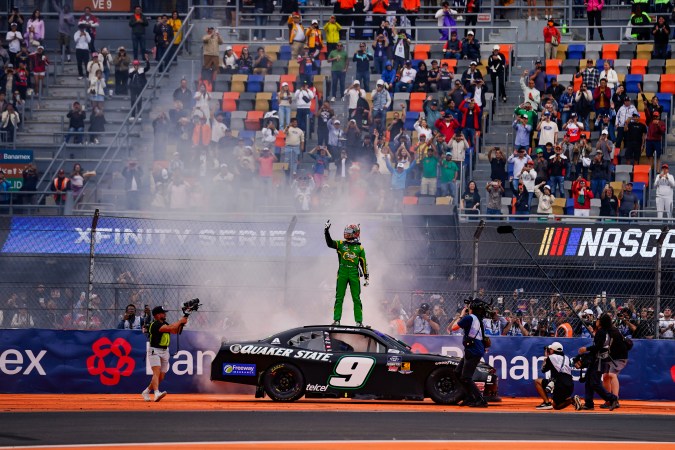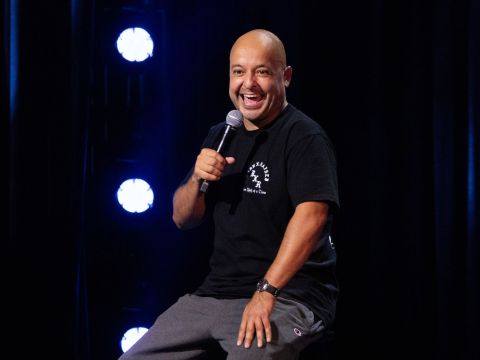Our communities love motorsports, but there’s no doubt that the average Latine fan invests more in F1 than they do in NASCAR. They know more about how F1 works, too, which is why, as Remezcla sat down with Mexican-American Daniel Suárez, who competes full-time in the NASCAR Cup Series, the focus was on his journey, making a space for Latinos to come after him, but also on what exactly he does and how it looks like, for those who might be new to the sport.
“There are many similarities, but there are also many very different things,” Suárez explained about the NASCAR vs F1 divide. “Let’s start with the different things. I think the biggest difference is that 80-85% of our races are on ovals and 15% are on circuits. Obviously, in Formula 1, all races are on circuits.”
Some well-known circuits on the NASCAR Cup series include the Circuit of the Americas in Austin, Texas, and Sonoma Raceway in Sonoma, California. An example of oval is the Indianapolis Motor Speedway.
“The second biggest difference is that Formula 1 cars weigh around 800 kilos (1763 pounds). NASCAR cars weigh more than 3,400 pounds, which is a lot more than a Formula 1 car weighs. So, the car is much heavier, much, much heavier. The car has a lot of power, but at the same time, you have a lot of power, but a lot of weight.”


And that affects how the car is driven. “The brakes are completely different, for example. Obviously, the Formula 1 car can stop very fast because it weighs very little. NASCAR cars need bigger brakes, and they can’t stop as fast because of the weight.”
“So, they are very different concepts, but at the same time, the similarity is that you have to drive a car to the limit. And it doesn’t matter if the car weighs 800 kilos or 2,000 kilos, you have to push it to the limit.”
And that requires preparation. People unfamiliar with motorsports can sometimes think that all the work goes into the car and anyone can drive it, but that is not true at all. “There are many things that are very important in how you prepare yourself to be the best driver you can be. Physical preparation is obviously very important; nutrition is very important.”
Plus, there are the intangibles. “A topic that many people don’t talk about is that having the talent to drive a car and working hard to be a good driver, when you reach a high level, that’s not enough. You also have to be a good leader. So, the way you communicate, the way you complain, the way you celebrate, all that will be reflected in the team.”
It is, indeed, a team effort, but the driver is a crucial part. “Once you reach a professional level, you have to be more than just a driver.”

“Obviously, the team is fundamental. There are a lot of people who are very, very important. And the driver is like the last piece of the puzzle. So, the driver has to give a lot of information to know what needs to be adjusted, in which direction we’re going to have to go. And the team also has to listen to it and make good decisions based on that.”
The economics of NASCAR also work very differently from F1. Formula 1 teams make money through prize money, yes, but also through sponsorships and investments from car manufacturers, which see winning teams as a way to make their cars more appealing to people. In NASCAR’s case, most of the money comes from broadcasting deals, sponsorship, and ticket sales—not car manufacturers.
“Notice that, unlike most other sports, we practically have brands everywhere. And the sponsors are really the ones who make the teams survive. In my case, Quaker State. And the sponsor, something that is very important, is not just a decoy in the car. You’re an ambassador for the brand. You have to have a connection with the brand, you have to be a good representative of the brand, you have to connect with your audience.”
Suárez is currently the only Latino in the NASCAR Cup Series. Not just that, he is the first Mexican-born driver to compete in and win a Cup Series race, and he has also won a NASCAR national series title. So, in many ways, though drivers like Colombian Juan Pablo Montoya had already succeeded at NASCAR, he is carrying the burden of representation.

“Imagine that when I came to NASCAR, there had practically never been a Mexican driver with success in the largest category in the United States, and it looked practically impossible. When I was trying to get to NASCAR, Juan Pablo Montoya was there, the Colombian. And he was doing things well. However, for some reason, something was still missing so that he could open the doors to Mexicans. Not only drivers, but also fans.”
Suárez is now making space for both, however. “It has been a great pride to be able to represent Latin America in the NASCAR world. I think that what has been possible in the last seven or eight years has never been experienced. We have many Hispanics who follow the sport, and many programs to make Latinos feel welcome.”
That will hopefully translate into more. “Why do you think we see a lot of Latinos in baseball? Because there are a lot already. When I got to NASCAR, there wasn’t anyone, so it’s much more difficult. But right now, a path is opening up, a door is opening up, and that’s fundamental.”
Not that it was easy for Suárez to get here.

“I had to learn everything from the language. I didn’t speak English when I moved here,” he told us. “I didn’t know I would be able to be a professional driver because in my family, when I was growing up, we didn’t have money. We didn’t have contacts. I saw the drivers on television as superheroes because I saw them as something unattainable. So, for me, I just kept racing cars. I won the next category, the next category, the next category. And eventually it started to become something that maybe I could get there.”
He has. And now, because he is, there might just be another kid, in Mexico or somewhere else in Latin America, who knows that they can also make it. There’s proof.
In the Zone with Lissete Lanuza Sáenz is where sports analysis meets cultural insight. I bring a unique perspective to the world of sports, blending passion with informed commentary.
Expect montly insightful analysis, exclusive interviews, and a celebration of the diverse voices shaping the sporting landscape.




